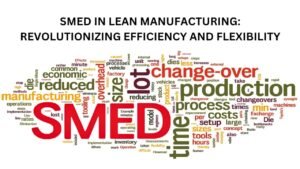In today’s fast-changing markets, customers demand more variety, faster delivery, and higher quality. To stay competitive, organizations need flexible manufacturing systems — and one of the most effective Lean tools to achieve that flexibility is SMED (Single-Minute Exchange of Dies).

⚙️ What is SMED?
SMED is a Lean technique developed by Shigeo Shingo that focuses on reducing setup or changeover time — the time taken to switch from producing one product to another.
The goal:
👉 Bring changeover time under 10 minutes (a “single-digit minute”) to enable quick, efficient transitions between products.
🧩 The Concept Behind SMED
Traditional changeovers can take hours, leading to downtime, large batch sizes, and lost productivity.
SMED simplifies and separates setup activities into two types:
-
Internal Setup: Tasks that can only be done when the machine is stopped.
-
External Setup: Tasks that can be done while the machine is still running.
By shifting more work to external setup and streamlining the rest, total changeover time can drop dramatically.
🔧 Steps of SMED
- Observe the current setup process.
- Separate internal and external activities.
- Convert as many internal steps to external as possible.
- Simplify, standardize, and streamline each task.
- Document and train for consistent execution.
🚀 Benefits of SMED
- Enables quick changeovers and smaller batch sizes
- Reduces downtime and increases equipment utilization
- Improves production flexibility and responsiveness
- Minimizes inventory and floor space
- Supports
Just-In-Time (JIT) and One-Piece Flow systems
🧭 Conclusion
SMED is not just about speed — it’s about flexibility and competitiveness.
By mastering quick changeovers, organizations can adapt faster, reduce waste, and serve customers more effectively — all while maintaining quality and efficiency.
“The faster you can change, the more flexible you become — and flexibility is the true strength of Lean manufacturing.”






